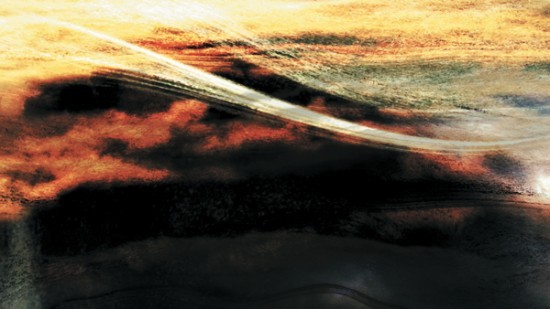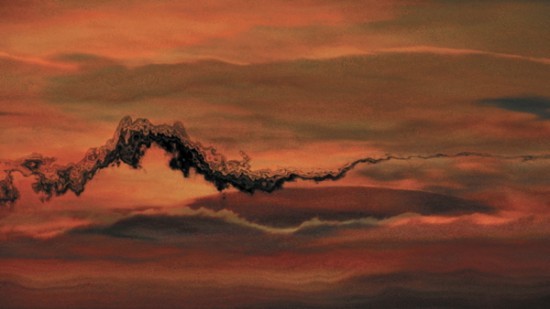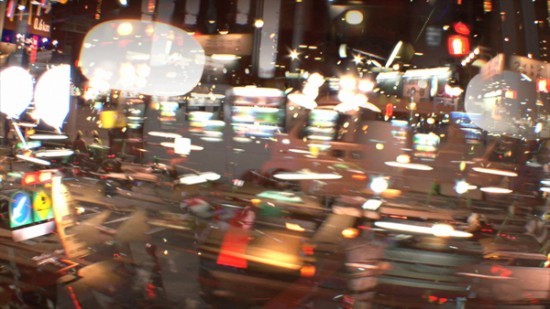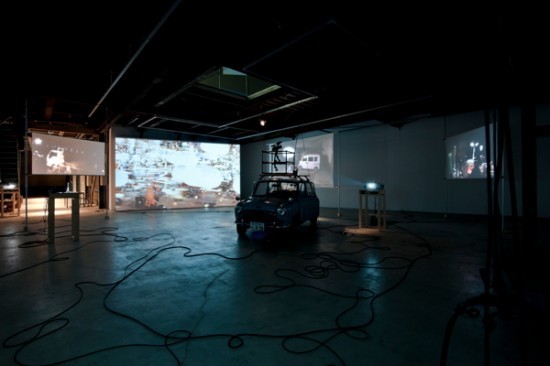Video and rhythm: Akira Miyanaga’s arc (2011) and scales (2011) (Part 1)
Generally speaking, the video art one sees these days in art exhibitions projected onto single or multiple screens in dark, partitioned rooms can be classified into three groups. The first consists of what might best be called “films” shot on video. In most cases, cuts, variations in playback speed and other editing techniques are used in such a way that what passes for a narrative unfolds across multiple screens (the work of Isaac Julian and Fiona Tan, for example). The second consists of “meta-movies” made up of content that represents an actual inquiry into film and video or even sight itself (the work of Bill Viola and Douglas Gordon, for example). Such works often employ techniques such as slow motion, fast forward, reverse playback and paused images that alter the perceptive conditions. The third group consists of all the rest, ie video art that is neither “film” shot on video nor conceptual art that addresses topics such as images and the sense of sight, but video art as strange, “primitive” art. To the extent that it is image-based, such art is essentially a photographed impression of the world (with specific time and place), but at the same time it closely resembles music in that it is art that manipulates time, or in other words it is charged with the duality of film and music.(1)


Both:Stills from Rainy Letter (2008), video installation.
Rainy Letter (2008), the work Miyanaga created while still a student at Kyoto City University of Arts that brought him into the limelight, and Wondjina (2009), his graduation piece, take as their raw material video fragments of water, clouds, the sun, landscapes, waves, letters and so on, and are visual music in the sense that subtle image transformation occurs between each fragment so that multiple layers of video are continually conjoining and separating. As for the filmic aspects of video art, these appear in limited form only as transitions that pleasantly betray the audience’s immersion in the abstract screen (the concentric circles of amplifying ripples metamorphose into letters, the ciliary movement in an abstract sequence is revealed to be a field of grass swaying in the wind, and so on). The issue is not the where and when of the water, clouds, sun, landscape or ripples, nor do the meanings of the letters floating on the water turn into any kind of message.


Both: Stills from Wondjina (2009), HD video, 14 min 24 sec.
That the essence of these works is the manipulation of time means that the issue at stake is “rhythm.” In film, there was the rhythm of cutting arising out of the montaging of individual shots. In an effort to escape from this filmic time division, the creators of early video art went in the direction of nullifying “cutting,” which is to say they dispensed with the “rhythm” of camera blocking and chose a tempo that was extremely slow or fast, as a result of which a rhythm peculiar to video was not given the opportunity to develop. In the world of music videos, on the other hand, the power of digital editing was used to synchronize sound and images, resulting in the merging of rhythm and beat, or the ceding of the rhythm of the images to the beat of the music. But what exactly do we mean when we talk of a rhythm peculiar to video?
In principle, video does not consist of discontinuous units in the form of “shots” and “cuts.” If film editing consists of cutting and pasting discontinuous units on a linear temporal axis, then video editing begins with the superimposing of layer after layer of groups of linear images that result from this. These layers are further broken down into aggregations of the visual “cells” (brightness, color, contour, direction of movement, etc) that comprise each layer, and a resonance between the layers arises as a result of the intertwining of these various elements. In other words, video art is the art of multiplexing filmic linearity into a musical polyphony, and accordingly the question becomes one of how to multilayer a single stream, or how to unravel the identity of a single layer of video, and the “rhythm” is related to the emergence of this polyphony.(2)
Well then, while the 1960s represented a turning point in the history of contemporary art, in the history of contemporary music they were a time of reaction to the avant-gardist total serialism of the preceding decade, the 1950s. Among the musical currents that typified the 1960s were the tone clusters of the likes of György Ligeti and Krzysztof Penderecki, the music of Iannis Xenakis, which could be described as a kind of structuralism different from total serialism, and minimalist music, and while the music of Iannis Xenakis ended up being at cross-purposes with total serialism due to its incomprehension of it, in contrast to this minimal music took on board its essence and was able to come up with an alternative answer to it.
Total serialism is a method of composition in which every musical element is determined and manipulated by a single series of values. The series functions as the music’s DNA, determining every aspect of it. However, this almost mechanical determination of the structure of the music based on a series is not the essence of total serialism. Rather, its essence lies in the determinism, or in other words in the extent to which one can bring about rich diversity from a single series.
Typical of the criticism directed at total serialism in the 1960s was that music generated in this way was too complex and that even after several listenings it was impossible to distinguish it from incoherent improvisation. In other words, while it may have been completely determined and may have given rise to rich diversity, these qualities were unrecognizable to the ears of most listeners. According to these critics, such music is overly conceptual, and overly technical. The task facing minimal music, which not only inherited the essence of total serialism but responded to these criticisms, was to create music that was completely structured and determined and capable of producing rich diversity and at the same time, unlike total serial music, totally listenable. As many readers will be aware, the answer was music in which single minimal patterns are repeated and layered in a cleverly staggered fashion. By repeating a certain pattern and layering over the top of it the same pattern in a staggered fashion, a new pattern akin to a moiré pattern emerges from the overlapping sounds, and by repeating and overlapping these new patterns yet more new patterns emerge.


Above: Still from about the lights of land (2010), 8 channel HD video installation. Below: Installation view at Kodama Gallery, Kyoto. Photo Nobutaka Omote.
As might be expected given how wonderful the previous work, Wondjina, was, Akira Miyanaga’s about the lights of land (2010) left something to be desired in terms of both quality and reception, but it was an ambitious work in which Miyanaga, who has a penchant for music, struck out into the filmic aspects of video art, choosing as his raw material sequences of panned shots of nighttime urban scenes taken from a camera mounted on a vehicle. In an attempt to multiplex the filmic linearity of the images into a music-like polyphony, he repeated these sequences as loops and staggered and layered them one after another. In other words, he used the same method as that used in minimal music. (To be continued)
Akira Miyanaga’s “scales” was on display at Kodama Gallery, Kyoto, from January 14 to February 11, 2012.
-
To the extent that it treats equally sound, images and words, digital video art in particular has much in common with both the electronic music of total serialism (such as Stockhausen’s Studie I and Studie II), which manipulated equally (through series with a single ratio) pitch, duration, strength and tone, and electronic music since the 1960s (such as Telemusik and Hymnen), which takes recorded sounds that evoke actual space or memories and transforms them into works by intermodulating them with electronically generated sounds.
- In terms of its music-like editing of film, a concept like Sergei Eisenstein’s “overtonal montage” might be more in sync with video. [See Sergei Eisenstein, “Methods of Montage,” in Film Form: Essays in Film Theory ; “Vertical Montage” in The Film Sense (p.74), both translated by Jay Leyda, (New York: Hartcourt); and “First Letter about Color,” trans. Herbert Marshall, Film Reader no. 2 (1977), p. 181-184.]
